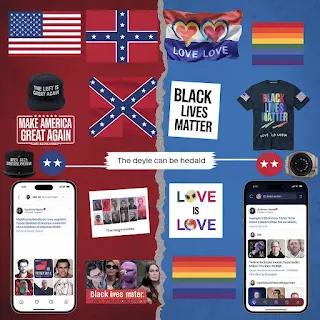"Political Polarization in America: Can the Divide Be Healed?"
Political polarization has become one of the defining characteristics of modern American society. As the ideological divide between liberals and conservatives widens, it raises pressing questions about the future of democracy in the United States. Is this growing divide permanent, or can the gap be bridged? In this blog, we’ll explore the current state of political polarization in America and consider potential solutions to heal the rift.
The Current State of Political Polarization
In recent years, political polarization has intensified. The 2024 elections have further highlighted how deeply divided the country remains on issues such as healthcare, immigration, climate change, and education. According to a Pew Research study, Americans are more ideologically consistent than ever before, with a significant portion of the electorate now identifying as either “very liberal” or “very conservative.” The center is shrinking, and the political discourse has become increasingly combative.
Social Media and Echo Chambers
One of the most significant contributors to this divide is social media. Platforms like Facebook, Twitter, and Instagram often create echo chambers where people are exposed only to viewpoints that align with their own. Algorithms reinforce these preferences, showing content that confirms biases and rarely challenging users with opposing viewpoints. As a result, many Americans find it difficult to engage in constructive political conversations across party lines.
The Role of Mainstream Media
In addition to social media, mainstream media outlets are often accused of contributing to polarization. With many cable news networks catering to specific political ideologies, viewers can choose to consume news that aligns with their beliefs, further reinforcing divisions. This creates a cycle where opinions become more extreme and nuanced discussions are rare.
Identity Politics and Division
Another factor driving polarization is the rise of identity politics. Issues related to race, gender, religion, and sexual orientation have become focal points of political debate. While these discussions are vital for social progress, they have also fueled tensions, as people increasingly define their political allegiances based on identity, making compromise difficult.
Can the Divide Be Healed?
While the current landscape of political polarization seems bleak, there are potential solutions to bridge the gap. Healing this divide will require a concerted effort from citizens, politicians, and media outlets alike.
Promoting Civil Discourse
One of the most critical steps toward reducing polarization is promoting civil discourse. Organizations like Braver Angels and The Better Arguments Project are working to encourage meaningful dialogue between people with opposing viewpoints. By fostering conversations rooted in empathy, these groups aim to reduce hostility and find common ground on key issues.
Reforming Social Media Algorithms
Tech companies must take responsibility for their role in exacerbating polarization. Reforming social media algorithms to promote diverse perspectives, rather than reinforcing echo chambers, could help users engage with opposing viewpoints more thoughtfully. Facebook and Twitter have begun experimenting with these changes, but more comprehensive efforts are needed.
Electoral and Political Reforms
Structural reforms in American politics may also help reduce polarization. Ranked-choice voting, for example, encourages candidates to appeal to a broader audience, potentially reducing extremism. Similarly, addressing gerrymandering and reducing the influence of money in politics could create a more balanced and representative system, leading to less divisive outcomes.
Focus on Local Issues
While national politics may be highly polarized, focusing on local issues can provide common ground for Americans. Local governments often deal with more practical matters, such as infrastructure, education, and public safety, which tend to be less ideologically divisive. Encouraging engagement in local politics could help foster a sense of community and reduce polarization at the grassroots level.
The Role of Leadership
Ultimately, healing America’s political divide will require leadership that promotes unity rather than division. Politicians, media figures, and public intellectuals must make a concerted effort to focus on policies that benefit the collective good, rather than stoking fear and resentment for political gain. Encouraging bipartisanship and elevating leaders who are willing to work across the aisle will be essential.
Conclusion
Political polarization in America is a complex and multi-faceted issue, but it is not insurmountable. By promoting civil discourse, reforming social media algorithms, and implementing political reforms, the country can begin to bridge the ideological divide. Healing this rift won’t happen overnight, but with collective effort, the future of American democracy can be one of collaboration rather than division.




